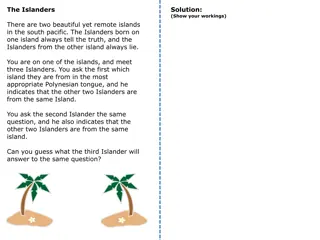Mandatory PFD Wear: The Tasmanian Experience Presentation Overview
The presentation delves into the importance of wearing personal flotation devices (PFDs) in Tasmania's boating activities, featuring before-and-after fatality rate comparisons. It explores the background of Tasmania, its boating areas, recreational boat ownership, and usage statistics. Insights from Mr. Peter Hopkins of Marine and Safety Tasmania are highlighted, emphasizing the need for PFDs to enhance boating safety in Tasmania.
Uploaded on Sep 07, 2024 | 0 Views
Download Presentation

Please find below an Image/Link to download the presentation.
The content on the website is provided AS IS for your information and personal use only. It may not be sold, licensed, or shared on other websites without obtaining consent from the author. Download presentation by click this link. If you encounter any issues during the download, it is possible that the publisher has removed the file from their server.
E N D
Presentation Transcript
Mandatory PFD Wear: The Tasmanian Experience Dr. L. Daniel Maxim, USCGAUX
Acknowledgement Thanks to Mr. Peter Hopkins, Recreational Boating Manager, Marine and Safety Tasmania (MAST), for sharing data and insights and for reviewing a draft of this presentation All data contained herein are for recreational boating only 2
Outline of presentation Background Before and After comparisons of fatality rates Concluding comments 3
Tasmania One of the states of Australia 2008 population approximately 500,000 Capital city; Hobart State is an island, south of Australian continent, separated from the mainland by the Bass Strait 5
Tasmania Area of Tasmania 26,410 sq mi, which is approximately the same size as West Virginia Coastline of Tasmania and islands ~ 3,033 miles, roughly 2.25 times that of Florida Registered boats per 100,000 population; 5,468, similar to Florida (5,119) 6
Tasmania Tasmania has many attractive areas for boating D Entrecasteaux Channel, shown at left is one popular location Other popular locations are Tasman Peninsula, Tamar River, and upper East Coast 7
Other boating areas Tasman Peninsula Boat Harbour Beach NW Tasmania Tamar River 8
Recreational boat ownership Results of 2007 survey shows most boats owned are 6 meters (19.7 ft) in length All motorboats (with 4 HP and over including PWCs) account for 90% of total 9
Recreational boat use Boating is popular sport in Tasmania Reported annual usage (times per year) of recreational boats in 2007 survey 10
Recreational Boating Recreational boating in Australia regulated by individual states; laws differ reflecting differences in environment (risk) Recreational boating authority Marine and Safety Tasmania (MAST) since 1997, replaced various Marine Boards around the State MAST proactive in safety area uses both voluntary and mandatory approaches 11
Recreational boat registrations Time series of number of registered boats in Tasmania shown at left Still relatively few in absolute number, comparable to boats in Wyoming, but relatively rapid growth (5.8% per year) Blue = actual data Grey = fitted 12
Regulation MAST proactive: Licenses required for all boats with 4 HP or greater applicants being required to log 20 hours of sea time or undertake a practical course before a license is granted Mandatory wearing of PFDs on boats under 6 meters in length (after 1 Jan 2001) when under power Mandatory carriage of EPIRBs for these craft in coastal waters Tasmania offers opportunity for before and after comparisons on mandatory PFD policies 13
Regulation Focus of recreational boating safety initiatives is on the development of a safety culture Regulations help to codify this culture it s the way we do things here not punitive top down approach Tasmania offers opportunity for before and after comparisons on mandatory PFD policies but changes in fatality rates reflect more than just mandatory PFD wear 14
Characteristics of a robust safety culture Informed Just Mindful Learning Reporting Flexible 15
Has regulation depressed interest in boating? Arguably Tasmania has the most stringent regulations for recreational boating of any state in Australia Some feared the end of boating in Tassie Figure at left shows % increase in recreational boat registrations (2000 to 2009) 16
Useful publication MAST maintains web site at http://www.mast.tas.gov .au/domino/mast/mastw eb.nsf/ Content interesting and relevant one publication provides summary of recreational boating initiatives 17
DATA AND BEFORE AND AFTER COMPARISONS 18
Drownings Figure at left shows pre- and post-law drowning time series Drownings relatively few and highly variable, year to year Mandatory PFD wear for vessels under 6 meters took effect on 1 Jan 2001 19
Drownings Mean drownings per year 3.5 before mandatory PFD regulation, 1.66 after; directionally consistent with hypothesis that mandatory PFDs save lives however sample size small and series variable 2-tail t test shows on borderline of significance (p = 0.104 assuming constant variance, p = 0.063 assuming unequal variance) 95% confidence intervals on difference in means (pre- and post-) include zero 20
Drowning rates Drowning rates per 100,000 boats also highly variable, but logically improved basis for comparison Mean prelaw drowning rate 29.2 compared to 7.44 per 100,000 boats after PFDs made mandatory on small boats 21
Drowning rates Difference in drowning rates per 100,000 boats both statistically and practically significant: (p = 0.011 with equal variance hypothesis and p = 0.004 if variances unequal) Statistical results consistent with hypothesis that mandatory PFD rule reduced annual drowning rate per 100,000 registered vessels 22
Box plot drownings Box plot of drowning rates shows difference between pre- and post- law periods Each observation corresponds to one year Very large scatter in pre-law period reflects outlier 23
Time series analysis Simple exponential fit (nonlinear least squares) shows that rate decreased by approximately 5.6% per year Substantial scatter in data and possible outlier probably distorts picture 24
Was 1999 atypical? The year 1999 had an unusual number of drownings, which actually spurred review of PFD policy; was this an outlier? Probably (p < 0.05 using either Grubbs or Dixon Q test), but conclusion that drowning rates per 100,000 registered boats (pre- and post-) are statistically different holds true even if this data point is deleted 25
What is a statistical outlier? Some data points in a sample will be further away from the mean than what is deemed reasonable Outlier points might indicate faulty or otherwise non- representative data Statistical procedures have been developed to identify and test for outliers It is reassuring if the presence or absence of presumed outliers has no effect on the conclusion(s), as is the case here 26
Box plot with outlier deleted Figure shows clear differences between pre- and post-law periods Outlier does not affect conclusion that post- law rates significantly lower than pre-law rates 27
Time series with outlier deleted Redo of model with outlier deleted and dummy variable to capture post-law period Best fit rate 5.3% per year, dummy variable coefficient = -5.7, right sign but NS Scatter still substantial 28
Wear rates Data on lifejacket wear rates in Tasmania are not published However, substantial anecdotal information supports claim that lifejacket wear rates in Tasmania are quite high ( 95%), reflecting diffusion of safety culture among boating public 29
Concluding comments Many studies (e.g., in Canada, the UK, Australia, and the US) have concluded that increases in lifejacket wear rates could decrease drownings substantially Tasmania case particularly interesting because both pre- and post-law data available; though sample sizes are small, results consistent with hypothesis that lifejackets save lives 31
Concluding Comments Safety improvements in Tasmania not solely due to requirements to wear lifejackets rather a MAST emphasis on safety culture Tasmania case also shows that stringent regulations do not necessarily impact participation http://www.theage.com.au/ffximage/2007/10/20/211007DEVIL_BABIES_wideweb__470x294,0.jpg 32























